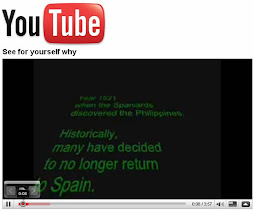VISUAL ARTS/PAINTINGS
(THEN AND NOW)
(best viewed if you personally visit the museum)
Title: Spoliarium
Artist: Juan Luna
This was to be his entity at the Madrid Exposition of 1884. It was an immediate sensation. It won not only the highest possible honor, the first of three Gold Medals, but also enthusiastic notice in the newspaper columns of Madrid, Barcelona, and Paris. Many of the notices were extravagant raves. Below are some of the remarks made by various cristics in those days:
-"The largest work, the most frightful, the most discussed work of the Exposition."
-"It is more than a painting, it is a book, a poem."
-"It is something more than the mere mechanism of genius, of the art composition. . . Luna is a thinker."
-"The superior qualities of Luna are: as an artist, his ambition to produce great designs; to subdue the multitude with the resources of the highest class in art; serious and rough, not with vile adulations from the pencil nor of color in beautiful lines; as a painter, his energetic style, broad and noble, truthful and on occasion fantastic."
-"A giant of art, a kind of Hercules, that enters furiously leveling down all the gods with blows from his club, bringing in a new art, full of ideas and forms, carrying a Spartan soul and the brush of Michelangelo. More than sixty years did Michelangelo study! How many years did Luna study? Six! Let us wait."
Per my own research...
"Nilampaso lang naman ni Juan Luna
at ng ibang Pinoy artist ang mga tinuturing
na pinakamagagaling sa "paintings" sa Europe
at buong mundo nuong panahon nila."
"Nilampaso lang naman ni Juan Luna
at ng ibang Pinoy artist ang mga tinuturing
na pinakamagagaling sa "paintings" sa Europe
at buong mundo nuong panahon nila."
It all happened when most of presently known Asian nations is still figuring out the meaning of modern art, Philippines was already making waves in Europe.
Consensus of opinion among critics, painters, and the press of Madrid and Barcelona was that Luna deserved, besides his gold medal, the rare and more prestigious "Prize of Honor" award, which had previously been conferred on Francisco Padilla, the greatest contemporary Spanish historical painter, in the 1878 Madrid Exposition. It must be remembered that in this same Exposition of 1884, another Filipino, Felix Resurreccion Hidalgo, won a silver medal for his entry, Christian Virgins Exposed to the Populace. No wonder the Filipino community in Madrid went wild with joy. The double victory called for a celebration, and a banquet was held at the Café Inglés, to which were invited some European friends. On this occasion, Rizal delivered his speech extolling the two winners to such majestic heights that today it is difficult to criticize the works of Luna and Hidalgo without inviting the censure of conservative admirers of their kind of painting. Rizal interpreted the Spoliarium as a symbol of "our social, moral, and political life: humanity unredeemed, reason and aspiration in open fight with prejudice, fanaticism, and injustice." On another occasion, Lopez-Jaena likewise read political implications in the Spoliarium, as follows: "For me, if there is something grand, something sublime, in the Spoliarium, it is because behind the canvas, behind the painted figures . . . there floats the living image of the Filipino people sighing its misfortune. Because. . . the Philippines is nothing more than a real Spoliarium with all its horrors.
"Portion of this writings were excerpt from the Article of Eric ToresRemarkable discovery"
Below are some of the known paintings then till present:
Below are some of the known paintings then till present:
Artist: BenCab
 Artist: BenCab
Artist: BenCab (still to be labeled)
(still to be labeled) (still to be labeled)
(still to be labeled) Artist: Ang Kiukok
Artist: Ang Kiukok (still to be labeled)
(still to be labeled) (still to be labeled)
(still to be labeled)Artist: Ang Kiukok
Artist: Ang Kiukok
 Artist: Ang Kiukok
Artist: Ang Kiukok (still to be labeled)
(still to be labeled)Artist: Botong Francisco
 Artist: Botong Francisco
Artist: Botong Francisco Artist: Felix Hidalgo
Artist: Felix Hidalgo Artist: Fernando Amorsolo
Artist: Fernando Amorsolo Artist; Fernando Amorsolo
Artist; Fernando Amorsolo
.jpg)



 (still to be labeled)
(still to be labeled) (still to be labeled)
(still to be labeled)









































































.jpg)



No comments:
Post a Comment